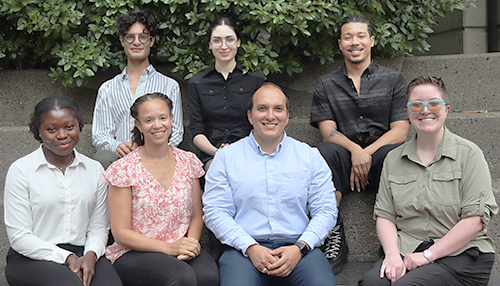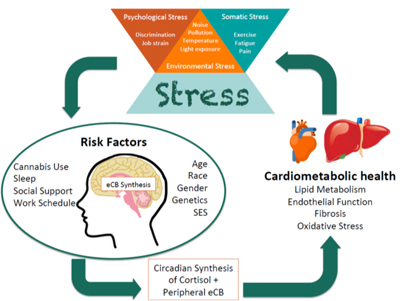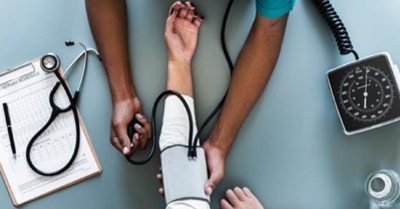Nicole Bowles Lab

Back, L to R: Omar Ordaz Johnson, Ayeisha Haswarey, Latroy Robinson (Aug 2022)
About Dr. Bowles
Dr. Nicole Bowles, OHSU’s 2021 Women in Academic Health & Medicine Emerging Leader, and Assistant Professor in the Oregon Institute of Occupational Health Sciences at Oregon Health and Science University, received a BS in Chemistry with a minor in Mathematics at New York University and obtained her Ph.D. in Neuroendocrinology from The Rockefeller University. She then went on to obtain her MS in Clinical Epidemiology from Weill Cornell Medical College. Her research is supported by the Ford Foundation, an American Academy of Sleep Medicine Young Investigator Award, and the National Institutes of Health.
Research Interests

Stress is a challenge for almost every worker. Dr. Bowles’ research laboratory examines the role of cannabinoid signaling in the modulation of sleep and circadian rhythms and how these signaling patterns buffer the cardiometabolic responses to psychosocial and environmental stress. Her interdisciplinary research uses a community-based participatory research framework to study populations of shift workers including on-duty Oregon firefighters as well as community engaged methods to bring diverse populations into a laboratory environment where she is able to control the environment and behaviors to systematically measure sleep and circadian phase.
Current Studies
Effect of tetrahydrocannabinol (THC) on sleep in humans (IRB #18052)
With cannabis use on the rise in the United States and a long history of relaxation inducing properties, Dr. Bowles aims to extend prior analysis of cannabis component exposure and sleep by looking at the association between THC exposure, sleep, and cognitive function. Her research team hopes to achieve these aims by measuring sleep and administering cognitive function tests to assess attention, verbal memory, and processing speed in healthy adult cannabis users and non-users. If you are interested in participating in this research and are a healthy adult between the ages of 21-35 please follow the link below.
Find out if you are eligible by filling out the pre-screen survey: https://is.gd/OHSUTHC
Shift work in firefighters:
IRB #20553

Firefighters encounter numerous work exposures and stressors that impact health behaviors and physiology, and ultimately elevate their risk for injury, mood disorders, and cardiovascular disease. In order to meet their occupational demands, recover during time off-shift, and spend time with family and friends, a number of fire departments have switched from a 24h on 48h off schedule to one that increases the number of consecutive days off with the trade-off of a 48h shift (e.g., 1 day on, 3 days off, 2 days on, 3 days off). Thus, in this study we aim to systematically examine the association between work schedule and psychosocial determinants of sleep (ex. work-life conflict), sleep duration/quality, safety and cardiovascular risk. Findings will be used to inform firefighting organizations about the current occupational, health, and family burdens firefighters are facing and point to possible program interventions to improve firefighter health as well as set a precedent for properly vetting alternative work schedules. The Bowles Lab is currently working with Portland Fire & Rescue, the Portland Firefighters Association, the Eugene-Springfield Fire Department, the McMinnville Fire Department, the Belton Fire Department in Missouri, and the West Jordan Fire Department in Utah. As of September 2021, this study is funded through the Oregon Healthy Workforce Center via the National Institute for Occupational Health and Safety and the COVID-19 American Rescue Plan. If you or your fire department are interested in learning more about this study, please email us at circadian@ohsu.edu.
Sleep and blood pressure in Black and White Americans:
IRB #16803

OHSU Researchers are seeking volunteers to investigate how the body’s internal clock affects blood pressure. In particular, we are interested in the decrease or “dip” in blood pressure during night and sleep because non-dipping blood pressure is a risk factor for cardiovascular events (ex. heart attack). To find out more about this study and eligibility requirements please visit: https://www.ohsu.edu/oregon-institute-occupational-health-sciences/health-disparities-hypertension
Recent publications
- Impact of firefighters’ work schedule on cardiovascular disease risk, wellbeing and safety in firefighters: protocol for the SWIFT study, a multidisciplinary prospective and cross-sectional study. Abdelmoaty WF, Watkins SL, Ayeni A, Hurtado DA, McHill AW, Biggs JJ, Hegmann KT, Shea SA, Bodner T, Bowles NP. BMJ Public Health. 2025;3(2):e002427.
- Sleep, psychological symptoms, and cannabis use before, during, and after COVID-19 “stay-at-home” orders: a structural equation modeling approach. Bowles NP, Rice SPM, Hebl J, Stewart AV, Shea SA. Journal of Cannabis Research. 2025;7(1).
- Cardiovascular disease risk: it is complicated, but race and ethnicity are key, a Bayesian network analysis. Bowles NP, He Y, Huang Y, Stecker EC, Seixas A, Thosar SS. Frontiers in Public Health. 2024;12.
- Identifying an Acceptable Number of Ambulatory Blood Pressure Measurements for Accuracy of Average Blood Pressure and Nocturnal Dipping Status. Brito LC, Rice SP, Bowles NP, Butler MP, McHill AW, Emens JS, Shea SA, Thosar SS. AJP Heart and Circulatory Physiology. 2024;327(2):H399-H405.
- Belonging, endurance, and resistance: Black placemaking theory in primary care. Ordaz OH, Croff RL, Robinson LD, Shea SA, Bowles NP. Social Science & Medicine. 2024;342:116509. doi:https://doi.org/10.1016/j.socscimed.2023.116509
- Brito LC, Bowles NP, McHill AW, Rice SPM, Butler MP, Emens JS, Shea SA, Thosar SS. Chronological distribution of readings in ambulatory blood-pressure monitoring exams affects the nighttime average and the magnitude of blood-pressure dipping. American Journal of Physiology-Heart and Circulatory Physiology. 2023;325(6):H1394-H1399.
- McHill AW, Thosar SS, Bowles NP, Butler MP, Ordaz-Johnson O, Emens JS, Purnell JQ, Gillingham M, Shea SA. Obesity alters the circadian profiles of energy metabolism and glucose regulation in humans. Obesity (Silver Spring, Md). Published online November 15, 2023.
- Bowles NP, Thosar SS, Butler MP, et al. The circadian system modulates the cortisol awakening response in humans. Frontiers in Neuroscience. 2022;16.
- Gonzalez JE, Shea SA, Bowles NP. Daily cannabis use is associated with sleep duration differentially across ages. Sleep Health. 2022;9(2).
- Bowles NP, Shea SA. Is the bedtime ingestion of hypertensive medications effective and safe? Sleep Medicine Reviews. 2021;59:101511.
- Optimization of Primary Care Among Black Americans Using Patient Portals: A Qualitative Study. Ordaz-Johnson O.H., Croff R.L., Robinson L.D., Shea S.A., Bowles N.P. (JMIR Preprint 2021)
- Interactions between home, work, and sleep among firefighters. Watkins, S.L., Shannon, M.A., Hurtado, D.A., Shea, S.A., Bowles, N.P. Am J Ind Med. 64 (2021): 137– 148.
- Not Just a Statistic: A Qualitative Study of COVID-19 Treatment and Prevention Optimization for Black Americans. Ordaz-Johnson O.H., Croff R.L., Robinson L.D., Shea S.A., Bowles N.P. Journal of General Medicine (2020): 1-3.
- Endogenous Circadian Rhythm of Mood is Diminished in Sleep Apnea. Emens J., Berman A., Butler M., Thosar S., Roberts S., Clemons N., Herzig M., Morimoto M., Bowles, N., McHill A. and Shea S. Psychiatry Research (2020): 113337.
- Circadian Rhythm of Vascular Function in Midlife Adults. Thosar, S.S., Berman, A.M., Herzig, M.X., McHill, A.W., Bowles, N.P., Swanson, C.M., Clemons, N.A., Butler, M.P., Clemons, A.A., Emens, J.S. and Shea, S.A. Arteriosclerosis, Thrombosis, and Vascular Biology 39.6 (2019): 1203 - 2011
- Separate and interacting effects of the endogenous circadian system and behaviors on plasma aldosterone in humans. Thosar S.S., Rueda J.F., Berman A.M., Lasarev M.R., Herzig M.X., Clemons N.A., Roberts S.A., Bowles N.P., Emens J.S., Ellison D.H., Shea S.A. Am J Physiol Regul Integr Comp Physiol. 316 (2018): R157 – R164
- Chronotherapy for Hypertension. Bowles N.P., Thosar S.S., Herzig M.X. and Shea S.A. Current hypertension reports. 11 (2018): 97
- Role of fatty acid amide hydrolase (FAAH) in the leptin-mediated effects on feeding and energy balance. Balsevich G., Sticht M., Bowles N.P., Singh A., Lee T.T., Li Z., Chelikani P.K., Lee F.S., Borgland S.L., Hillard C.J., McEwen B.S., Hill M.N. Proceedings of the National Academy of Sciences. 29 (2018): 7605-7610.
- Lowest perceived exertion in the late morning due to effects of the endogenous circadian system. Thosar S.S., Herzig M.X., Roberts S.A., Berman A.M., Clemons N.A., McHill A.W., Bowles N.P., Morimoto M., Butler M.P., Emens J.S. and Shea S.A. Br J Sports Med. (2018): bjsports-2018.
- Recent legalization of cannabis use: effects on sleep, health, and workplace safety. Bowles N.P., Herzig M.X., Shea S.A. Nature and science of sleep. 9 (2017): 249
- Trouble in transit: Organizational barriers to workers' health. Bowles N.P., McEwen B.S., Boutin-Foster C. Am J Ind Med. 60.4 (2017): 350-367.